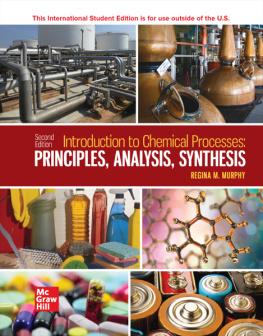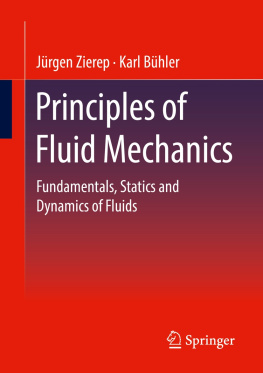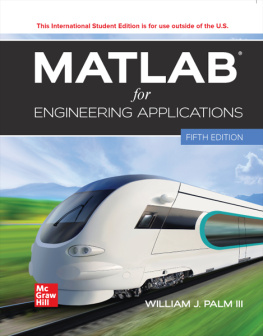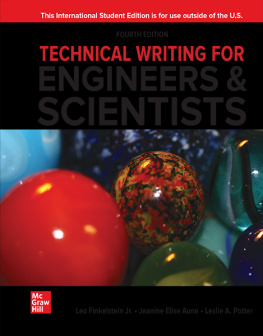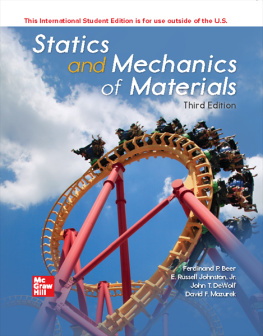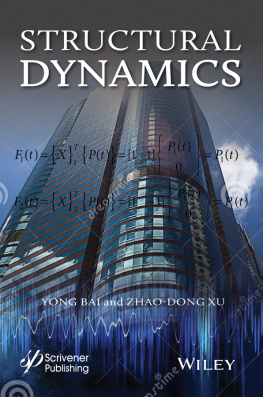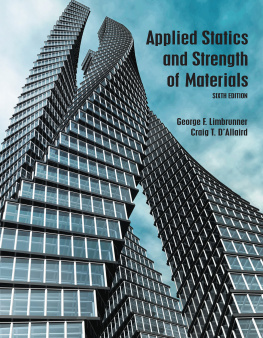
page i
Engineering Mechanics
STATICS & DYNAMICS
THIRD EDITION
Michael E. Plesha
Professor Emeritus, Department of Engineering Physics
University of WisconsinMadison
Gary L. Gray
Department of Engineering Science and Mechanics
Penn State University
Robert J. Witt
Department of Engineering Physics
University of WisconsinMadison
Francesco Costanzo
Department of Engineering Science and Mechanics
Penn State University

page ii

ENGINEERING MECHANICS: STATICS & DYNAMICS
Published by McGraw Hill LLC, 1325 Avenue of the Americas, New York, NY 10019. Copyright 2023 by McGraw Hill LLC. All rights reserved. Printed in the United States of America. No part of this publication may be reproduced or distributed in any form or by any means, or stored in a database or retrieval system, without the prior written consent of McGraw Hill LLC, including, but not limited to, in any network or other electronic storage or transmission, or broadcast for distance learning. Some ancillaries, including electronic and print components, may not be available to customers outside the United States.
This book is printed on acid-free paper.
1 2 3 4 5 6 7 8 9 LWI 26 25 24 23 22
ISBN 978-1-265-25541-1
MHID 1-265-25541-5
Cover Image: NASA/MSFC; NASA
All credits appearing on page or at the end of the book are considered to be an extension of the copyright page.
The Internet addresses listed in the text were accurate at the time of publication. The inclusion of a website does not indicate an endorsement by the authors or McGraw Hill LLC, and McGraw Hill LLC does not guarantee the accuracy of the information presented at these sites.
mheducation.com/highered
page iii
ABOUT THE AUTHORS
Michael E. Plesha is a Professor Emeritus of Engineering Mechanics in the Department of Engineering Physics at the University of WisconsinMadison. Professor Plesha received his B.S. from the University of IllinoisChicago in structural engineering and materials, and his M.S. and Ph.D. from Northwestern University in structural engineering and applied mechanics. His primary research areas are computational mechanics, focusing on the development of finite element and discrete element methods for solving static and dynamic nonlinear problems, and the development of constitutive models for characterizing the behavior of materials. Much of his work focuses on problems featuring contact, friction, and material interfaces. Applications include nanotribology, high-temperature rheology of ceramic composite materials, modeling geomaterials including rock and soil, penetration mechanics, and modeling crack growth in structures. He is coauthor of the book Concepts and Applications of Finite Element Analysis (with R. D. Cook, D. S. Malkus, and R. J. Witt). In addition to teaching statics and dynamics, he also has extensive experience teaching courses in basic and advanced mechanics of materials, mechanical vibrations, and finite element methods.
Gary L. Gray is an Associate Professor of Engineering Science and Mechanics in the Department of Engineering Science and Mechanics at Penn State in University Park, PA. He received a B.S. in mechanical engineering (cum laude) from Washington University in St. Louis, MO, an S.M. in engineering science from Harvard University, and M.S. and Ph.D. degrees in engineering mechanics from the University of WisconsinMadison. His primary research interests are in dynamical systems, dynamics of mechanical systems, and mechanics education. For his contributions to mechanics education, he has been awarded the Outstanding and Premier Teaching Awards from the Penn State Engineering Society, the Outstanding New Mechanics Educator Award from the American Society for Engineering Education, the Learning Excellence Award from General Electric, and the Collaborative and Curricular Innovations Special Recognition Award from the Provost of Penn State. In addition to dynamics, he also teaches mechanics of materials, mechanical vibrations, numerical methods, advanced dynamics, and engineering mathematics.
Robert J. Witt retired from the University of WisconsinMadison, Department of Engineering Physics, in 2020 after a 33-year teaching career. He received his B.S. in mechanical engineering from the University of CaliforniaDavis and his M.S. and Ph.D. in nuclear engineering from MIT. His research interests were in computational methods in fluid and solid mechanics, with particular applications to nuclear systems. He taught 20 different courses over the span of his career, including statics, dynamics, mechanics of materials, and a variety of other classes in applied mechanics, computational methods, and nuclear engineering. He is coauthor of the book Concepts and Applications of Finite Element Analysis (with R. D. Cook, D. S. Malkus, and M. E. Plesha).
page iv
Francesco Costanzo is a Professor of Engineering Science and Mechanics in the Engineering Science and Mechanics Department at Penn State. He received the Laurea in Ingegneria Aeronautica from the Politecnico di Milano, Milan, Italy. After coming to the United States as a Fulbright scholar, he received his Ph.D. in aerospace engineering from Texas A&M University. His primary research interest is the mathematical and numerical modeling of material behavior. His specific research interests include the theoretical and numerical characterization of dynamic fracture in materials subject to thermo-mechanical loading, the development of multi-scale methods for predicting continuum-level material properties from molecular calculations, and modeling and computational problems in bio-medical applications. In addition to scientific research, he has contributed to various projects for the advancement of mechanics education under the sponsorship of several organizations, including the National Science Foundation. For his contributions, he has received various awards, including the 1998 and the 2003 GE Learning Excellence Awards and the 1999 ASEE Outstanding New Mechanics Educator Award.
page v
The authors thank their families for their patience, understanding, and, most importantly, encouragement during the long years it took to bring these books to completion. Without their support, none of this would have been possible.
page vi
BRIEF CONTENTS

page vii
STATICS TABLE OF CONTENTS
page viii
page ix
page x
page xi
DYNAMICS TABLE OF CONTENTS
page xii
page xiii
page xiv
PREFACE
Welcome to statics and dynamics! With this book we hope to provide a teaching and learning experience that is not only effective but also motivates your study and application of statics and dynamics.
1. Learn the fundamental principles of statics and dynamics; and
2. Gain the skills needed to apply these principles in the modeling of real-life problems and for carrying out engineering design.
To achieve the objectives cited above, we have developed this book as follows. First, we provide a rigorous introduction to the fundamental principles. In a constantly changing technological landscape, it is by understanding fundamentals that you will be able to adapt to new technologies. This book places great emphasis on developing problem-solving skills. The need for an engineer to be able to accurately model real-life problems and solve them is obvious. Beyond this, it is only by mastering problem-solving skills that a true, deep understanding of fundamentals can be achieved. Second, we incorporate pedagogical principles that research in math, science, and engineering education has identified as essential for improving learning. These include teaching concepts in parallel with problem-solving skills, identifying and addressing misconceptions, and assessing conceptual understanding via specific problems. Third, we have made modeling the underlying theme of our approach to problem solving. We believe that modeling, understood as the making of reasonable assumptions to reduce a real-life problem to a simpler but tractable problem, is also something that must be taught and discussed alongside the basic principles. Fourth, we emphasize a systematic approach to solving every problem, an integral part of which is creating the aforementioned model. We believe these features make this book new and unique, and we hope that they will help you learn and master statics and dynamics.
Next page


